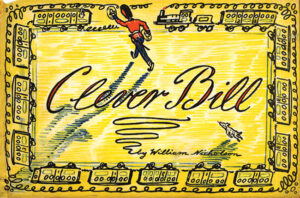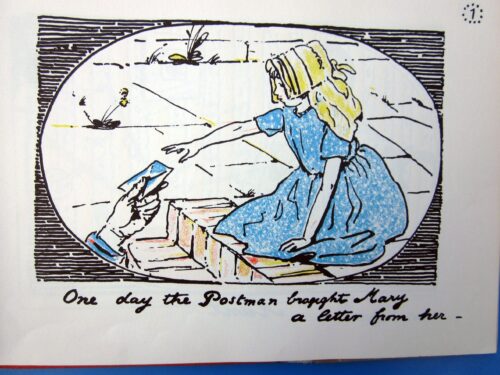And now a word in support of listservs.
In an era where serious debates attempt, and fail, to be conducted on such sites as Twitter, a place never meant for serious discussions of any significant length, allow me to sing the praises of an almost old-fashioned web tool that continues to have meaning and currency long after many would have predicted its demise. Listservs, those mailing lists where people talk to one another via email in a digest form, have survived the rise and fall of Pets.com, Friendster, and I’d warrant that they’ll outlive many of the social networking sites we lean so heavily upon today. In the world of children’s literature we saw the relatively recent demise of the ccbc-net listserv, but I am happy to report that the child_lit listserv out of Rutgers is alive and well. If you have not joined it, feel free to do so. Where else can you hear Philip Pullman in talks with Jane Yolen or see Leonard Marcus wax eloquent?
Sometimes the conversation on child_lit has greater implications as well. Recently Marilynn Olson wrote the following:
I have learned this week that the reissue of Clever Bill (William Nicholson, 1926) that is in process at Egmont Publishing intends to leave out the handwritten lettering that is an integral part of the pages (see Barbara Baden or Nathalie op de Beeck, or Brian Alderson on this subject) (or Michael or me or Selma Lanes) and replace it with italic printing on the grounds that modern children (toddlers?) and possibly their parents do not know how to read joined-up lettering. Other much more minor editorial changes are also contemplated.
Maurice Sendak was probably Nicholson’s greatest fan in America, and even if you haven’t read Clever Bill, perhaps you have seen his comments. To some of us, the Nicholson picturebooks changed the history of the American picturebook and, indeed, of the kind of picturebooks we think of as ideal. (. . .) I guess I am trying to determine whether this seems serious to many?
 A hot little debate followed, but this choice on the part of the publisher did not particularly surprise me. I remember working as a children’s librarian in the Central Children’s Room of NYPL and encountering a 10-year-old girl in search of funny books ala Wimpy Kid. I loaded her down with the usual fare, making sure to slip one of my favorite books, The Popularity Papers by Amy Ignatow, into the mix. She returned to me at the desk with the book in hand. “I can’t read script.” It took me a little bit to realize that “script” meant “cursive”. I knew that kids weren’t being taught to write it anymore (mostly) but did that mean they couldn’t read it either? Apparently so in this case. However, what this also proved to me was that an enormously popular series can actually include “script” and pretty much get away with it. You’ll have some kids who won’t try to decipher it, but you’ll also have a huge swath who will.
A hot little debate followed, but this choice on the part of the publisher did not particularly surprise me. I remember working as a children’s librarian in the Central Children’s Room of NYPL and encountering a 10-year-old girl in search of funny books ala Wimpy Kid. I loaded her down with the usual fare, making sure to slip one of my favorite books, The Popularity Papers by Amy Ignatow, into the mix. She returned to me at the desk with the book in hand. “I can’t read script.” It took me a little bit to realize that “script” meant “cursive”. I knew that kids weren’t being taught to write it anymore (mostly) but did that mean they couldn’t read it either? Apparently so in this case. However, what this also proved to me was that an enormously popular series can actually include “script” and pretty much get away with it. You’ll have some kids who won’t try to decipher it, but you’ll also have a huge swath who will.
In the case of Clever Bill, here are some of the interior images that will give you a better sense of what the book looks like with its cursive handwriting intact:
The debate is whether or not the book is ruined irreparably if the handwriting here is not cursive any longer. And while I might argue that to replace it with typewritten words would throw off the whole shebang, if it is carefully done and it still looks like handwriting (and not that computer font that looks like fake handwriting) I personally see no reason why it would hurt the book significantly. There are many who would disagree, but sadly I would argue that in this particular case the book will only appeal to those prone to nostalgia, collectors, and already existing children’s literature enthusiasts if the handwriting is left intact. It is the placement of the text that makes all the difference here, I think.
It is interesting to note that my first encounter with Clever Bill came in the NYPL archives. There we had an edition of Clever Bill filled with pencil notations by author William Nicholson himself. It seems that he was mighty displeased with the initial print job of the book and set about kvetching in his tiny comments about the book’s poor colors. Had he but known that it would be the handwriting that caused debate nearly 100 years later, I think he would have laughed in his tea.
For further information about Clever Bill, as well as his far more controversial Pirate Twins, please see the Werewolf piece Classics: The Pirate Twins (1929) by William Nicholson.
And for thoughts on cursive in children’s literature, the 100 Scope Notes piece “What Does This Say?” The Cursive Conundrum in Picture Books is for you.





Perhaps if it was hand-lettered but in print instead of cursive they could maintain the feeling of the book. I still write in cursive, but I don’t have much opportunity to read it anymore so even as an adult, I’m getting out of practice.
I just ordered a used copy of this book after reading about it on the listserv! I had never heard of it before. Can’t wait to receive it and see what all the fuss is about.
The Babar books were originally published with the text in a form of cursive, but long ago that was changed to ordinary typography. This change may have been long in the works, pushed along by the growth of international publishing.
I had forgotten. Were they in cursive when they were initially translated to English or were they English cursive translations?
HOW I love this book! One of my childhood favorites. I love the minimal colors and calligraphic drawings. I think they’ll be able to get a beautiful result with a carefully chosen typeface. But it must be clever!
I found learning cursive in school tedious and difficult, so I’m glad that teachers will be using that time for what I hope will be more enriching instruction. But, I ended up adopting cursive as an adult out of my own volition, because I do my drafting by hand and spend a lot of time taking notes in seminars. Cursive is just faster and pleasanter in these contexts, and so I’m glad I had the knowledge in me to adopt it when I needed to (also, I kind of like that it’s hard for people to see what I’m writing over my shoulder).
More importantly, this all just makes me think of the Berly Cleary book Muggie Maggie.